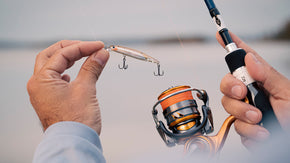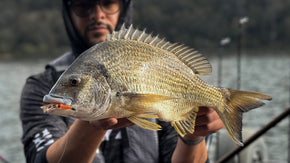Posted 01th October 2025
Planning Your First Impoundment Barra Trip


By Robert Thornton
Over the past 30 years stocked impoundments have become popular fishing destinations, and nowhere is this more apparent than the barra-filled lakes of the country’s north. Since barramundi first became a viable target behind dam walls all those years ago, sportfishing fanatics have built a mythology around them. This fanfare has reached a point where we sometimes think of them as a completely different species from their wild counterparts!
In this blog, we’re going to try cut through the mystique and provide you with the tools to plan your first trip to catch impoundment barra. We’ll cover the physical tools you’ll need and how to set them up, as well as the mental tools you can employ to outsmart these wily lake dwellers. We’ll also look at the logistical side of an impoundment barra trip, which will be especially useful for those who need to travel some distance.

WHY GIVE A DAM?
When discussing stocked barramundi as a sporting proposition, it’s not unusual for all sort of opinions to start flying around. Common ones I’ve heard include “it’s not real barra fishing”, “it’s like shooting fish in a barrel”, or even “they don’t fight as well as wild fish”. I’d like to have some of my own opinions on record – opinions founded on lots of experience chasing both impoundment and wild fish. Firstly, a barra is a barra is a barra. Secondly, impoundment barra can be difficult (sometimes more difficult than wild fish) to fool, and can leave even the most skilled and initiated barra diehards scratching their heads. Finally (and I’ve said this before), anyone who says lake fish don’t fight probably hasn’t caught one.
With that out of the way, we can get to why impoundment barra are so highly sought, and that’s their growth potential. Barramundi in lakes enjoy an environment free of tidal movement with as much food as they can eat, all with little to no predation once they reach a certain size.
Because of this, most barra dams have a high proportion of large, well-conditioned fish that test heavy tackle to its absolute limit. To reiterate; impoundment barra fight hard! Big and heavy though they may be, I’ve seen metre-plus fish jump 2-3 times their body length out of the water in scenes resembling tarpon fishing in the Florida Everglades!
Big fish are available in the wild, but the simple truth is that you’re far more likely to crack the metre mark fishing in an impoundment.
Other reasons for fishing in dams instead of wild settings for barra include fewer hazards such as crocodiles, big tides and other dangers associated with tropical estuaries. Many dams stocked with barra also sit closer to major sub-tropical population centres than the wild barra Meccas in Far North Queensland and the Northern Territory.
Of course, wild barramundi still hold a special place in my heart, but I’ll always jump at the few chances I get these days to chase extra-large specimens in the dams, and I know I’m not alone.

PLANNING YOUR FIRST TRIP
Travel, accommodation and budgeting
When planning your first trip, it’s important to ask yourself a few questions. If travelling a fair distance (as many of us will need to), how long can you realistically spend up there? And how much of that time will be spent travelling?
For a trip to have a reasonable chance of success – especially for newbies – a party will need to spend at least a few days there. Setting aside a few days means there’s time to get a lay of the land, talk to locals, relax between intensive fishing sessions, plus it leaves enough leeway to resort to a plan B if needed.
Granted, getting time away from work and family commitments is never easy, and you’ll need to factor in travel time as well. For extra-long journeys, sharing driving responsibilities to punch it out in one go instead of stopping overnight is one way to save time. With that in mind, I always advise against driving while tired, and you should have a means of stopping overnight if all drivers are not feeling sufficiently energised.
Then comes budgeting. Most lakes offer comfortable accommodation onsite in the form of cabins, nearby motels, powered campsites and so on. On the other hand, those on a tight budget might be better off camping with basic setups in designated areas.
Some of my most memorable barra trips have involved roughing it on the lake’s edge, with each of us curled up in our swags after a long night session, trying to catch up on sleep and slurping beans out of a tin. Other times, I’ve been treated to airconditioned dongas with Netflix on the telly, where the standard fare is locally sourced beef and vegetables, with some fresh redclaw tails fried in butter as a bonus. My point is, whatever your budget, you should be able to make it work for you.
Another important consideration is batteries. On long trips, boat batteries can become a source of bother when charging options are limited. While most campsites, holiday parks and motels offer powerpoints for battery chargers, some lakes have relatively few amenities. In these scenarios, your options are to keep your trips short, use your electric motor sparingly, or pack extra batteries.
If all this is beyond the capabilities of your arsenal or it just sounds too daunting, another option is to hire a guide! There are guides operating on most barra impoundments, and they all know their local water like no one else. With most guides, the only thing you need to do is get yourself to the dam and they’ll sort out the rest!

Gearing up
A boat is virtually a must for impoundment barra fishing, but there are exceptions. Certain lakes can be and sometimes are fished on foot, especially when the water level is low. One example is Lake Callide in Central Queensland, which has seen quality fish landed (literally) by those walking the bank when drought conditions have reduced it to a large pond. For the most part though, a vessel of some sort, whether a boat, canoe or kayak, is going to be helpful.
Next is electronics. Sounders have become a standard part of the impoundment barra kit in recent decades, and though live sonar technology and detailed bathymetric maps come standard with many modern units, they are very expensive and take a lot of skill to use. The good news is this isn’t going to be make-or-break a trip. As a minimum, I recommend having at least one unit with a screen size of 7 inches or larger, with some basic features like water temperature, depth, side-scan and mapping of some sort.
Electric motors are another key item on most barra boats, as they allow you to manoeuvre in amongst shallow areas without disturbing the water too much. Another plus of having a ‘leccy is the electric anchor feature that most models come with these days. Before live sonar technology took hold in Australia, one very effective technique (which is still effective) was to fish from a stationary boat, which was positioned in an area where barra were likely to move through at some point. Anglers used anchors or tied up to trees before electric motor technology included electric anchor functions – nowadays it’s as simple as pressing a button and you’re all set!
Another thing to consider is having your boat set up for night fishing, which is common practise the barra lakes. You’ll need to have a 360-degree white light (also known as an anchor light) and working navigation lights to comply with the law. Also preferable is some form of lighting for the deck area, and storage to keep hooks and other hazards out of the work area – there’s nothing worse than getting a barra-gauge hook in your skin at night!
The tackle you decide to take is ultimately up to you, but there are a couple of outfit types that, between them, will allow you maximum versatility out on the dam. I outline four outfit types for barra plus some lures to pair them with here.
Mental prep
Part of the preparation stage involves getting yourself in the right headspace and knowing what the expect. Of course, no two dams are the same, and barra behaviour and their movements within the dam can change on a daily basis. In my Complete Guide to Impoundment Barra blog, I go into the complexities of these fish, with top info straight from the minds of some of Australia’s best barra anglers.
Barra fishing in dams is as much a mental game as it is a physical one, and in my personal experience, half the battle is being able to fish with confidence and trust your decisions. Mistakes will be made, sure, but this is how we learn – both on and off the water.
Finally, while it’s great to have a game plan for your upcoming trip, it’s also important to allow yourself to be flexible, and to adapt if the situation requires you to.
DAMMED IF YOU DO
Fishing in impoundments for barra is not for the fainthearted, and certainly not recommended for those just starting their fishing journey (unless hiring a guide). With that said, the satisfaction of a plan coming together and the site of a giant, chromed beast on the deck of the boat makes the weeks of preparation and hours of casting all worth it. With each fish comes a new piece of knowledge that will make you a better angler as well.
Good luck if you’re planning your first impoundment barra trip this season! Hopefully you’ll get to see why these fish have such a cult following all around the country!
















